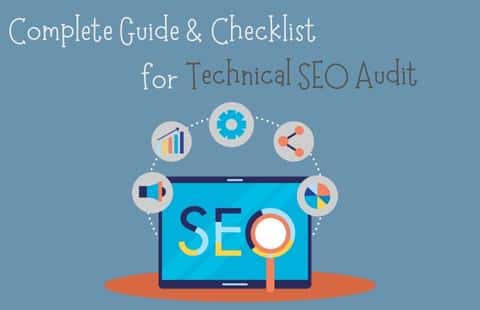- January 3, 2023
- techAdmin
- 0
Technical SEO Audit- Complete Guide & Checklist for 2023
Why do you want to do specialized technical SEO audits for your website?
I’ll explain why it’s essential. Because of the ever-increasing competition, you must stay at the top of your game in the digital marketing industry.
You must pay attention to SEO because it is a big part of any website’s success.
SEO is essential to any online business’s success. Approximately 61% of marketers state that SEO is the primary focus of their inbound marketing efforts.
You might have done an excellent job of building your website with the help of skilled web developers.
However, your website will not be able to compete in the rankings of various search engines if the SEO is normal.
Technical SEO audits are necessary to ensure that your SEO is the best.
They will give you an idea of where your website ranks on various search engines and what you need to do to get there.
It need not be difficult or time-consuming, even though it may appear to be.
SEO tools can carry out a technical SEO audit quickly and easily. Additionally, that brief period may significantly impact your search engine ranking.
Let’s first examine the definition of a technical SEO audit before moving on to a more in-depth discussion of the subject.
What is a Technical SEO Audit?
You must ensure that your website and content are highly ranked on Google Search Console. Keyword stuffing and getting backlinks from micro-sites are no longer necessary.
You need to work harder and align your SEO strategy with the most recent changes in Google Search Console.
How can a technical SEO audit improve your website’s ranking?
The process of checking the technical aspects of your website’s SEO is called a technical SEO audit. It evaluates a website’s health and identifies potential enhancements.
Search engine robots look for pages and websites by crawling the web. Before placing your website in the search results, the bots check your pages for various ranking factors.
SEO is constantly evolving, and your rivals are also adapting to these changes. As a result, it’s critical that you stay current to remain relevant in search results. You might lose visitors to your rivals if you don’t check the health of your website.
Monthly mini-audits are a good idea because search algorithms and technology change frequently.
It would help if you guaranteed that you genuinely lead an undeniable specialized Search engine optimization review each 4-5 months.
What Factors Affect Your Website’s SEO Performance?
Three broad categories encompass the primary factors that affect the SEO of your website.
Technical aspects: include indexing, page loading speed, and hosting.
ON Page factors: Site content, target keywords, and related terms are examples.
OFF Page factors: These include external references to your website from other websites as well as backlinks.
Each of these factors needs to inspect regularly. It guarantees you are always aware of the industry’s shifting conditions.
Your website’s mobile readiness is one of the most important considerations to keep in mind.
Since mobile devices account for approximately 60% of all searches, Google Search has begun to prioritize mobile-friendly websites.
How do you go about carrying out a technical SEO audit?

Since it has become so undeniably evident what specialized Website optimization review is and what boundaries remember for it, we should investigate how you can direct one.
1. Start by Crawling Your Website
The crawling of your website must be the first step in any technical SEO audit. You can use programs like SEMrush, Spyfu, or DeepCrawl.
SEMrush’s On-Page Website optimization Checker likewise furnishes you with important proposals to develop further your webpage’s Search engine optimization system, backlinks, specialized Website design enhancement , and content quality.
You are aided in finding errors by the crawlers, such as poor images, title issues, broken links, and incorrect keywords.
Additionally, they can assist you in identifying unlinked pages, duplicate content, and excessive redirects.
Your crawl budget can also view in the Google Search Console.
Your crawl budget is the number of pages and frequency with which Google Analytics crawls your website.
You can see how the Google Analytics bot is crawling your website by looking at your crawl budget.
Remove Duplicate Content
Your crawl budget can be easily wasted on duplicate pages. To locate duplicate pages, you can make use of tools like SEMrush.
These pages’ Meta descriptions and title tags typically share the same format.
You should exclude as many duplicate pages as possible; however, if you have to keep them, you should exclude them from the search engine bots.
Restrict Indexation
Pages like the Privacy Policy and the Terms and Conditions might not need to appear in search engine results.
You can refuse these pages from being filed and save money on the creep financial plan.
Fix Redirects
The crawl budget is wasted on every redirect the Google Analytics bot takes.
Also, if there are a lot of 301 or 302 redirects, the bots might stop following them and not get to the intended page.
Technical SEO audits will help reduce the number of redirects, crawling, and indexing issues.
Check your SEO score
The SEO score of your website can be obtained from sites like SEO Site Checkup—this score, out of 100, indicates your strengths and weaknesses.
This score can help you decide what to do next in your technical SEO audit. The checkup can help you identify the keywords you use the most. It can also assist you in locating code mistakes and broken links.
You can also determine whether your website supports robots.txt and sitemap. When calculating the score, malware or phishing activity on your website is considered.
2. Review Sitemap
Your website’s sitemap is essential. It can inform search engines about the structure of your website and assist them in discovering new pages.
If you want your SEO strategy to work, you need a sitemap. As a result, you must check it during the technical SEO audit.
Check to see that your sitemap includes the following:
Clean: Your sitemap must not contain any errors at all. Remove URLs and redirects that can prevent indexing. Search engines may ignore your sitemap if they are not.
Concise: The sitemap should be reasonably brief. The Google Analytics bot will only crawl it if it contains at most 50,000 URLs.
As a result, you should keep it brief and include all relevant pages.
Daily updates: All your most recent substances should be added to your sitemap as and when distributed. Search engines may find new content more quickly as a result of this.
Registered in the Google Search Console: You are required to inform Google Search of your sitemap. There are two ways to achieve this: by hand and by indicating its location in robots.txt.
3. Check Internal Links
Your website’s search engine rankings can significantly benefit from a logical hierarchy. As a result, both its internal and external links need to check.
Site pages can likewise be erased or moved, bringing about a wrecked connection.
Which internal linking factors ought to be examined?
During the technical SEO audit, you can check the following things about your internal linking:
Click depth the number of clicks that separate a particular page from the homepage is shown in click depth. It would help if you ensured this number was as low as possible.
It ought to be less than 3. You can find this out using Website Auditor and going to Pages, then Site Structure. The click depth will be displayed in one of the columns.
Links that need to be fixed broken links can drain your crawl budget. They are bad for your website because they can even frighten visitors.
Within Website Auditor, select Internal Resources from the All Resources dashboard. To locate broken links, sort the list according to the HTTP Status Code.
Orphan Pages are pages on your website that aren’t linked to any other pages and can be hard to find for search engines.
In Website Auditor, go to Pages and Site Structure to find orphan pages.
4. Test Site Speed
Regarding SEO, your site speed is an essential parameter. People prefer to wait for websites to load; the longer a website takes, the more likely visitors will leave.
Therefore, testing the speed of your website is a prerequisite for any technical SEO audit.
What is the connection between page load speed and bob rate?
The likelihood of a bounce increases by 90% if your website takes five seconds to load.
When determining your rankings, Google Analytics will soon consider site speed.
As a result, you need to check and slow down your website. You can involve Google Pagespeed Bits of knowledge for this.
It will demonstrate how well your website stacks up against other websites and how quickly it loads.
The best feature of this tool is that it demonstrates how to increase speed.
5. Check HTTPS Content
On Google Search’s first page, about 70% of the results are HTTPS. In your technical SEO audit, you must look for common HTTPS issues if your website already uses HTTPS.
What are the regular HTTPS gives most sites? You should check your HTTPS site for the following things:
Links, Canonicals, and Redirects your website’s links, canonicals, and redirects must point to HTTPS pages.
Your website might have HTTP to HTTPS redirects, but sending users through redirects could be better.
The redirects may also hamper crawling. You will waste the crawl budget each time the Google bot hits a redirect.
Blended Content, The composite substance issue emerges when secure pages load dangerous substances like pictures and recordings. The page’s security may be compromised as a result.
It can even prevent browsers from loading the entire page or unsecured content by using this feature.
Go to Site Audit in Website Auditor to look for this problem. You must check the HTTPS Pages With Mixed Content Issues option to locate the mixed content.
Website Auditor also lets you look at the complete list of your website’s non-HTTPS resources. Sort the URLs in the Internal Resources section.
The HTTP pages will be visible to you first. Verify the complete list of pages that link to each HTTP page. It also shows where the link is, making it easy to fix things.
6. Do a Backlink Audit
It should be no surprise that the technical SEO audit includes backlinks because they are crucial to your website’s success. They demonstrate to search engines how valuable your website’s content is to users.
However, in off-site SEO, crawlers look beyond just hyperlinks.
The Google bot also looks for mentions of your brand on your website. As a result, it’s critical to keep track of your website’s online and offline activities.
You can use tools like Ahref to conduct a backlink audit. It might let you know what kinds of backlinks are coming to your website.
7. Re-Crawl Your Website
You can ask Google to re-crawl the website once the issues in the technical SEO audit have been resolved.
The technical SEO audit’s final step will ensure that your modifications are immediately considered.
To accomplish this, navigate to Google Search Console, select Crawl, and tap Fetch as Google. Tap on Fetch after entering the URL that needs to be re-crawled.
You will need to click Submit to Index to request that Google re-crawl your page after the Google bot has retrieved it.
You can submit the exact URL or the URL with all of the pages that are linked to it.
Google will begin indexing content based on the URL in the latter scenario. It will then crawl your website by following all of the internal links.
Choose ZabTech as your auditing partner. We’ll collaborate with your team closely. It will identify your issues. The audit will be documented, explain each point, prioritize our findings in a roadmap, make recommendations, and plot the milestone for your organic search campaign.

